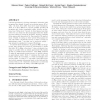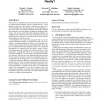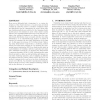SIGMOD
2008
ACM
14 years 11 months ago
2008
ACM
Extracting dense sub-components from graphs efficiently is an important objective in a wide range of application domains ranging from social network analysis to biological network...
SIGMOD
2008
ACM
14 years 11 months ago
2008
ACM
With ever-increasing amounts of graph data from disparate sources, there has been a strong need for exploiting significant graph patterns with user-specified objective functions. ...
SIGMOD
2008
ACM
14 years 11 months ago
2008
ACM
Online bibliographic databases, such as DBLP in computer science and PubMed in medical sciences, contain abundant information about research publications in different fields. Each...
SIGMOD
2008
ACM
14 years 11 months ago
2008
ACM
In the implementation of hosted business services, multiple tenants are often consolidated into the same database to reduce total cost of ownership. Common practice is to map mult...
SIGMOD
2008
ACM
14 years 11 months ago
2008
ACM
Current approaches to develop information extraction (IE) programs have largely focused on producing precise IE results. As such, they suffer from three major limitations. First, ...
SIGMOD
2008
ACM
14 years 11 months ago
2008
ACM
There has been a significant amount of excitement and recent work on column-oriented database systems ("column-stores"). These database systems have been shown to perfor...
SIGMOD
2008
ACM
14 years 11 months ago
2008
ACM
We present SchemaScope, a system to derive Document Type Definitions and XML Schemas from corpora of sample XML documents. Tools are provided to visualize, clean, and refine exist...
SIGMOD
2008
ACM
14 years 11 months ago
2008
ACM
SIGMOD
2008
ACM
14 years 11 months ago
2008
ACM
How can we efficiently find a clustering, i.e. a concise description of the cluster structure, of a given data set which contains an unknown number of clusters of different shape ...
SIGMOD
2008
ACM
14 years 11 months ago
2008
ACM
Today's query processing engines do not take advantage of the multiple occurrences of a relation in a query to improve performance. Instead, each instance is treated as a dis...



